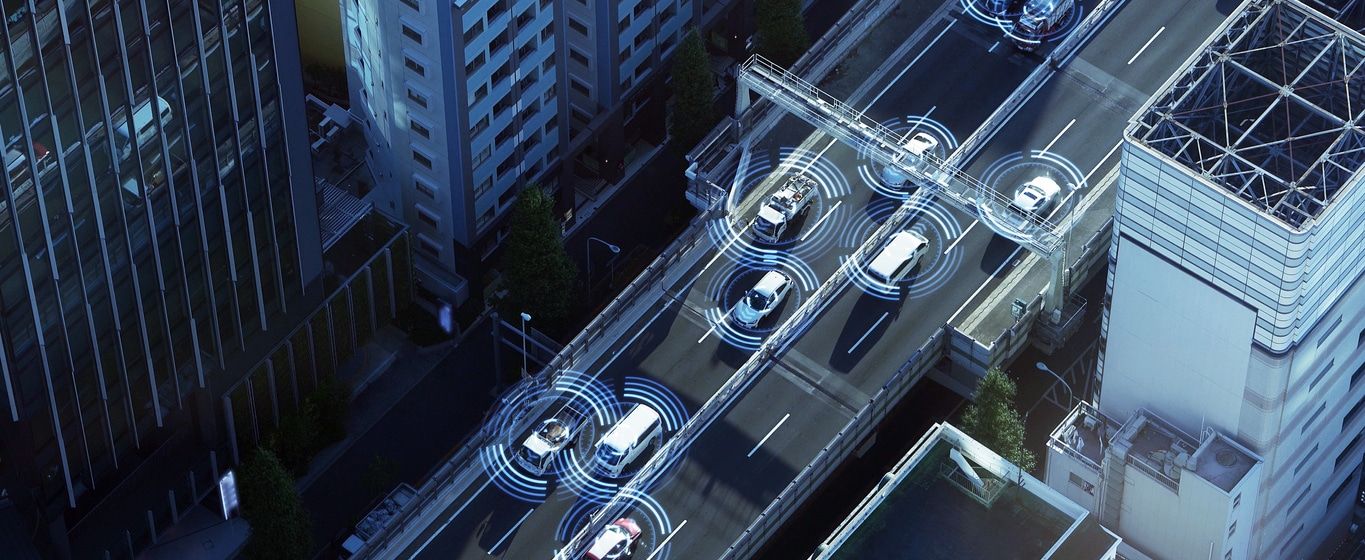
5GAA Releases White Paper on Making 5G Proactive and Predictive for the Automotive Industry
We are at the dawn of a new era of mobility. Future intelligent transportation systems will provide tremendous benefits to people and society in terms of lives saved, increased time and money efficiencies, reduced environmental impact, as well as better utilization of the global road and highway networks. Automated and connected driving, intelligent driver assistance and data-driven transportation network optimisation are examples of what tomorrow’s transportation will mean for people and governments. A key enabler of this development is that mobile networks fulfil the requirements of future transportation.
5G Automotive Association (5GAA) has developed the concept of predictive Quality of Service (QoS), which is a mechanism enabling mobile networks to provide advance notifications about predicted QoS changes to interested consumers. This makes it possible to adjust application behaviour before the predicted QoS change takes effect, which is important to certain automotive use cases, such as remote and autonomous driving.
The concept of predictive QoS is spreading in the industry and among standards- developing organizations (SDO). It is, therefore, of interest to achieve a common understanding of what predictive QoS is – what problems it addresses, as well as how they are addressed.
This White Paper describes predictive QoS in order to reach a common understanding.
You can find the white paper here.

5GAA in Action
The 5G Automotive Association (5GAA) is a global, cross-industry organisation of 128 members made of leading global automakers, Tier-1 suppliers, mobile operators, semiconductor companies and test equipment vendors. It works together to develop end-to-end solutions for future mobility and transport services.
5GAA is committed to defining and developing the next generation of connected mobility, automated vehicle and intelligent transport solutions based on C-V2X.
Learn more about what actions the associations are taking in the video.
5GAA in Action
The 5G Automotive Association (5GAA) is a global, cross-industry organisation of 128 members made of leading global automakers, Tier-1 suppliers, mobile operators, semiconductor companies and test equipment vendors. It works together to develop end-to-end solutions for future mobility and transport services.
5GAA is committed to defining and developing the next generation of connected mobility, automated vehicle and intelligent transport solutions based on C-V2X.
Learn more about what actions the associations are taking in the video.

5GAA live demos show C-V2X as a market reality
Turin, 14 November 2019 – Smart mobility technology is a reality today, with ‘Cellular Vehicle-to-Everything’ (C-V2X) allowing connected vehicles to communicate with the cloud, directly with each other and their surroundings. Deployment plans are primarily sustained by the global trend in the automotive industry to adopt 4G LTE cellular technology, followed by the emerging 5G high-speed low latency communications. Beyond infotainment, C-V2X will capitalize on vehicular and smartphone connectivity to contribute to better safety, less congestion and reduced emissions.
During a live demo event in Turin, the 5G Automotive Association (5GAA) showcased ready to deploy use cases in the streets of the city and a sneak preview of what the future has in store on the renowned Lingotto rooftop test track.
Prominent members and partners of the 5GAA including Audi, Continental, Ericsson, Fiat Chrysler Automobiles, Harman Samsung, Marelli, Pirelli, Qualcomm, TIM and Vodafone demonstrated the current state of C-V2X and the road to future, Vehicle-to-Vehicle (V2V), Vehicle-to-Infrastructure (V2I), and Vehicle-to-Network (V2N) applications based on 4G LTE and 5G.
“Connected mobility is a market reality.” says 5GAA Chief Technology Officer, Dr. Maxime Flament. “The use cases demonstrated in the streets of Turin are planned for deployment with a huge industry momentum based on the evolution path to 5G capabilities.”
Using both direct short-range communications and mobile networks, the open-road demonstrations showcased the extensive capabilities of today’s C-V2X technology, ready for deployment. To name a few:
- Protecting vulnerable road users, for instance, by alerting drivers about a pedestrian at a crossing using LTE-connected infrastructure.
- Smoothing traffic by allowing public authorities and road operators to provide real-time warnings to drivers in urban environments concerning roadworks or speed limits, via the network.
- Preventing incidents at dangerous intersections or in the event of unexpected braking, thanks to C-V2X direct-short range communications between vehicles.
The track demonstrations at Lingotto underlined the enhanced safety benefits that can be expected thanks to the versatility of 5G and the wide range of services it enables. To name a few:
- Vehicles will geo-tag dangerous areas for the following cars or provide ‘see-through’ functions to avoid dangerous overtaking.
- Pedestrians will be detected directly via their smartphones and surrounding vehicles will be warned.
- In case of accidents, emergency services will be able to visualize the situation live using on-board cameras of surrounding vehicles, improving response times and providing emergency responders situational awareness prior to arriving at the crash scene.
Furthermore, Intel showcased an “In Vehicle Entertainment” demo at the Museum, in collaboration with Marelli, TerraNet and Equinix, showing how Multi-Access Edge Computing (MEC) can support immersive high-definition (HD) entertainment for all occupants of a moving vehicle, including video streaming, gaming, virtual reality (VR), office work, online education, advertisement.
A short summary on each of the 5GAA C-V2X use cases, demonstrated today in Turin
Demo 1 “Vulnerable Road Users”: open road demos on safety
In this trial – which is part of Torino Smart Roads Initiative patronized by the Municipality of Turin – TIM, Links Foundation and Luxoft showed how the communication between the various actors moving along the roads can help in detecting potentially dangerous situations. The goal of the demos was to demonstrate how the 5G mobile network facilitates the protection of Vulnerable Road Users: pedestrians (“Presence of a pedestrian on a crosswalk”) and cyclists (“Presence of a connected bike on the road”). In the case of a pedestrian approaching a crosswalk, a Roadside Unit connected to the mobile network, equipped with a camera able to detect the event, sent a warning message to the nearby connected vehicles (I2V communication). In the case of a connected bike and a connected vehicle that are approaching each other, the two vehicles received a warning message about their presence when a risk of collision is detected.
Demo 2 “Urban Georeferenced Alerting” in open roads
TIM, FCA, Links Foundation, City of Turin with 5T, and Politecnico di Torino showed how the Local Traffic Authority in Turin intends to notify drivers in real time of possible dangers and special situations on the road (traffic jam, road works warning, dynamic speed limit, etc.). A standard geo-referenced warning message was dispatched to a TIM AMQP broker” at the edge of the 5G mobile network and only the involved vehicles received the geo-localized message from the AMQP Broker using the TIM 5G Network. The warning was read and displayed in an FCA vehicle through the on-board HMI and can for instance notify the driver of upcoming speed reduction. The aim of the trial was to demonstrate how the TIM 5G Network is suitable for realizing smart roads services for connected cars. The solution is compliant with the standards so it can be applied in other locations covered with mobile networks.
Demo 3 Intersection Movement Assist (IMA), Forward collision Warning (FCW)
FCA and Harman Samsung showcased two Vehicle to Vehicle (V2V) demos, by integrating C-V2X direct-short range communication into Maserati Levante and Quattroporte. The vehicles, through a direct radio link (network-less radio link), anonymously communicated basic information such as their position and related direction.
The Forward Collision Warning (FCW), detected possible frontal collision and warned the driver accordingly. The Intersection Movement Assist (IMA), assisted the driver at the cross junctions to avoid a possible lateral collision with an oncoming vehicle.
Demo 4 Emergency Electronic Brake Light (EEBL), Stationary Vehicle Warning (SVW)
FCA, Continental, and Qualcomm demonstrated fast and reliable information exchange between vehicles in emergency situations. The two demos are based on C-V2X direct-short range technology, enabling Vehicle-to-Vehicle (V2V) communication between two Jeep Renegade. There were two portions to this demo:
- “Stationary Vehicle Warning” (SVW): when the hazard lights are activated, the application broadcasted a message to all nearby vehicles so that approaching vehicles could be informed even if the hazard was not visible.
- “Emergency Electronic Brake Light warning” (EEBL): in the event of a sudden braking, the application broadcasted a message to following vehicles, such that approaching vehicles were notified of the potentially dangerous situation.
Demo 5 See-through
Vodafone, FCA, Vodafone Automotive, Marelli and Altran revealed the ‘See Through’ that uses C-V2X long-range cellular network communication to exchange streamed video in real time between vehicles, extending the driver’s visual range under obstructed visibility scenarios and to prevent accidents, especially those that may occur in an overtaking phase. The two involved Jeep Renegades vehicles were equipped with a connectivity solution (Marelli) and high frame-rate cameras (Marelli Motorsport) to detect the road lanes.
A real time tracking system and a space mapping algorithm of the vehicles, specifically developed by Vodafone Automotive, allowed Vodafone’s Multi-access Edge Computing (MEC) to dynamically manage and route the video flows on the basis of the vehicles’ relative positions and to ensure minimal end-to-end latency in the interest of drivers’ safety. Vodafone 5G ultra-low latency and high reliability were paramount to ensure the flow and synchrony of the real-time video exchange between vehicles, also under high traffic and cell saturation conditions.
Demo 6 World-first 5G-enhanced ADAS services
Audi, Ericsson, Italdesign, KTH, Pirelli, Qualcomm, TIM and Tobii showed how smart cars, commercial 5G smartphones and 5G networks jointly improve comfort, safety and efficiency. This unique collaboration combined the power of eye-tracking glasses, intelligent tires, in-vehicle augmented reality and 5G phones to work together over a live 5G network. With its high capacity and low latency, cellular 5G connectivity is ready to enable instantaneous cooperation between vehicles, the IoT ecosystem and more advanced driver assistance services. The live demonstrations at the Turin Lingotto test track were based on TIM’s commercial 5G network delivered in Turin in partnership with Ericsson. Audi cars, equipped with Pirelli Cyber Tyre, and embedded 5G modems provided by Qualcomm and available 5G smartphones were utilized to enhance pedestrian’s safety.
About 5GAA
The 5G Automotive Association (5GAA) is a global, cross-industry organisation of over 130 members comprised of leading global automakers, Tier-1 suppliers, mobile operators, semiconductor companies and test equipment vendors. It works together to develop end-to-end solutions for future mobility and transport services. 5GAA is committed to helping define and develop the next generation of connected mobility, automated vehicle and intelligent transport solutions based on C-V2X.
Learn more on the 5GAA website and follow us on Twitter and LinkedIn.
Media Contacts
5GAA Marketing & Communications
Email: marcom@5gaa.org
Official pictures: Conference – Demonstrations
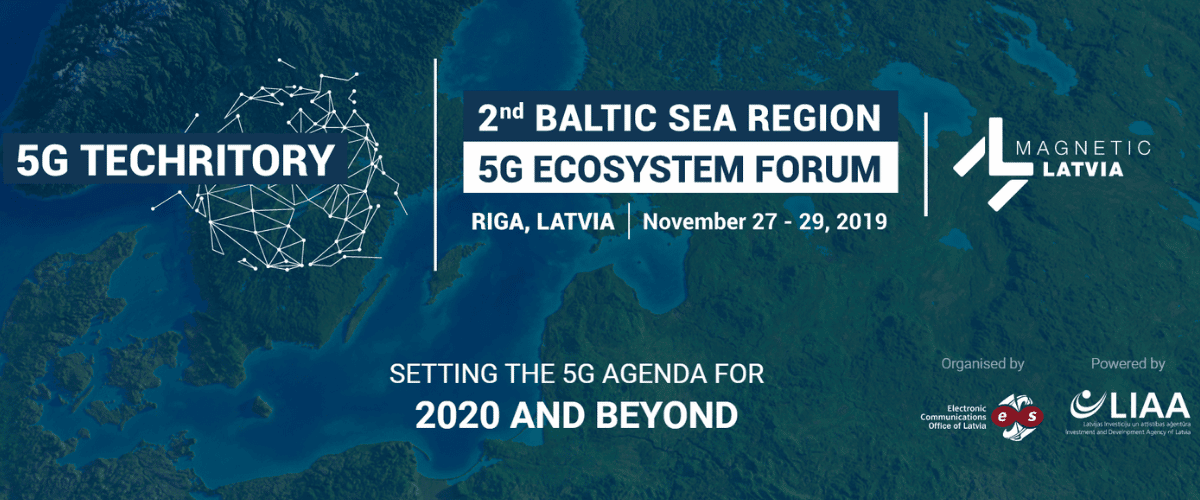
5GAA to be main supporting partner of 5G Techritory – Riga, 27-29 November 2019
5G Techritory is the annual Baltic Sea Region 5G Ecosystem Forum organised by the Electronic Communications Office (ECO) of Latvia, aiming at gathering decision makers, major representatives from industry associations, and business leaders to discuss the deployment of the earliest available commercial applications of 5G technology. Its second edition is going to be held in the Latvian capital, Riga, on 27-29 November.
Taking place in a vibrant region for 5G implementation, the 5G Automotive Association is proud to be confirmed once again as one of the main partners of this conference. 5GAA Director General Johannes Springer is going to participate as a speaker in front of an audience of up to a thousand senior professionals invited upon an attentive selection to ensure the highest quality of debate.
The Baltic Sea Region includes nine countries comprising of a population of 150 million people. Among the Baltic countries, Latvia appears in the third place of the 5G Readiness ranking according to the European Commission’s Digital Economy and Society Index (DESI) 2019 report. This result shows that the potential for international leadership in the field is highly promising and this edition has all the characteristics to be a must-visit, given the renewed interest for digital and technology of the newly appointed European Commission.
Since the objective of the programme is to focus on what is readier for commercialisation, four verticals have been identified as the main topics:
- Smart City
- Smart Mobility
- Industry 4.0
- Smart Media and Entertainment
In addition, a 5G policy hackathon, a key stakeholders’ roundtable and an exhibition are scheduled as side events.
Registration is open and all the possible interested participants are encouraged to apply.
See the official press release and leaflet.

C-V2X contributes to safer roads for everyone: 5GAA live demo event in Berlin
Photos of the workshop can be found here. Click here to see the photos of the live demonstration.
Berlin, 23 May 2019 – Smart mobility technology, which we have been developing over the years, is now a reality. ‘Cellular Vehicle-to-Everything’ (C-V2X) allows vehicles to both communicate with the cloud and also directly with each other and their surroundings. Thanks to 4G LTE cellular technology, as well as the emerging 5G generation of high speed and low latency communications, traffic will be optimized, and emissions will be reduced. Emergency services will navigate smoothly and road safety for everyone, including vulnerable road users, will dramatically enhance.
At a live demo event in Berlin, the 5G Automotive Association (5GAA) presented a deep-dive into a smarter and safer mobility, giving a sneak peek of the technologies ready to be deployed. Prominent 5GAA members including BMW Group, Daimler, Deutsche Telekom, Fraunhofer Institutes FOKUS and ESK, Ford, Huawei, Jaguar Land Rover, Nokia, Qualcomm and Vodafone, demonstrated C-V2X Vehicle-to-Vehicle (V2V), Vehicle-to-Infrastructure (V2I) and Vehicle-to-Network (V2N) applications.
“Connected mobility standards are no longer a vision for the future,” says Maxime Flament, Chief Technology Officer at 5GAA. “The solutions on show are ready to be deployed today and have huge industry momentum based on the forthcoming 5G capabilities. C-V2X technology is a key foundation for a safe and sound driving environment for pedestrians, bicyclists, motorcyclists, cars and commercial heavy trucks. Global field testing is already in its very final stages and the first solutions are now commercially available from multiple suppliers.”
Using both direct short-range communications and mobile networks offers complementary capabilities as showcased in the demos, which involve tele-operated driving and the provision of emergency traffic information between vehicles using multi-access edge computing (MEC) functionality. All the demos use technology that is ready to be deployed.
A short summary on the 5GAA C-V2X use cases, showcased today at Berlin:
1. A. Traffic Management Solutions: Signal Phase and Timing (SPaT) and Red-Light Violation Warning (RLVW) to Vehicle
Waiting at the red light is not only time consuming, but idling, braking and accelerating release more pollutants. The communication between the traffic signal and vehicle is important to improve traffic flow, thus increasing road safety by preventing accidents. During the demo drive, a BMW Group vehicle equipped with a Qualcomm onboard unit running the Savari ITS software stack and the V2X use cases, communicates with a SWARCO traffic signal, showing C-V2X readiness across multiple vendors.
The use case enables the driver to monitor the upcoming traffic light. The center display of the vehicle shows the current signal phase and how long it will remain. In the Red Light Violation Warning (RLVW) use case, the application in the vehicle uses its speed and acceleration profile, along with the signal timing and geometry information from the traffic signal. If the driver is likely to run a red light he/she receives a warning in the vehicle.
B. Traffic Management Solutions: Emergency Electronic Brake light (EEBL)/ Roadworks warning (RWW)
C-V2X provides the driver with information so that he or she can adapt to the upcoming traffic situation in advance. Fraunhofer FOKUS, supported by Daimler, demonstrate an Emergency Electronic Brake Light Warning: Two vehicles equipped with Huawei onboard units are accelerating, and the car ahead brakes hard. The second car instantly receives a warning, demonstrating the advantage of the low-latency C-V2X communication. Furthermore, a Huawei roadside unit communicates ongoing roadwork via C-V2X to the vehicle. Visitors experience both use cases in the car viewing the warnings on the central display.
2. Real Time Emergency Alerts: Vehicle-to-Network and Network-to-Vehicle services
Vodafone Germany and Ford show connected vehicle technology (V2X) that could alert drivers to an accident ahead, moments after it has happened (via eCall Plus). Furthermore, the system provides early warning that emergency vehicles are approaching – and which side of the road other vehicles should move towards to avoid being an obstruction. Experts believe that survival rates for road accident victims can be improved by as much as 40% if they receive treatment just four minutes more quickly.
3. Live data capture and transmission: Expanded network/Vehicle-to-Network capacities via MEC
An ultra-fast, reliable and precise dissemination of safety-relevant information can save lives. Continental, Deutsche Telekom, Fraunhofer ESK and Nokia demonstrate how information is delivered to vehicles almost real-time via a mobile network, utilizing Multi-Access Edge Computing (MEC) technology. All data is processed at the edge of the mobile network to reduce transmission time (latency). As a result, event-related data such as emergency warnings as well as high-definition map data are transmitted in milliseconds, improving driving safety on the path to fully automated driving.
4. Combined Network and Direct solution enables the pinnacle of C-V2X technology
Vodafone Group, Huawei and Jaguar Land Rover demonstrate safety critical use cases by combining different communication modes (short direct via PC5 and longer-range network-based via Uu). The provision of a two-stage warning enables vehicles to be made aware of other vehicles approaching the same junction much earlier and allowing action to taken sooner to avoid a crash. Also, the number of road accidents because of unsafe lane changes and blind spots are significant. Using C-V2X technology helps automotive OEMs keeping the cost of implementing such warnings down by not having to install additional ‘one-off’ radio access systems for such warnings. The demos showcased the value and readiness of C-V2X and its ability to seamlessly combine both long range and short-range direct and longer-range network communication links. Specifically, it was shown that at a T-junction – a key site for accidents – connected cars benefit from longer range cellular network communication to deliver safety-related information beyond what alone can be delivered from short-range technology.
5. Remote-operated driving
Remote-Operated Driving (ROD) smooths the path to automated vehicles, anticipating situations in which remote human operator can intervene with the driving of the vehicle. ROD is enabled by low latency communication equipment e.g. by Huawei to deliver instructions or inputs to the vehicle to help it navigate challenging scenarios. Fraunhofer Institute FOKUS, supported by Daimler, showcase the reliability ROD enables already today.
_______________
Contact
Marketing and Communications Team
Email: marcom@5gaa.org

5GAA co-organizes 5G Vertical User Workshop alongside 5G-IA, 5G-ACIA, and PSCE
On 12 and 13 February 2019, the 5G Vertical User Workshop, an initiative of 3GPP Market Representative Partners 5GAA, 5G-IA, 5G-ACIA and PSCE, was organised as a collaborative event for strategic dialogue between industries and 3GPP by exchanging on future needs and upcoming cellular standard developments. The workshop as a result, aimed to produce a report shared directly to 3GPP Project Coordination Group (PCG) as a mean to stimulate and facilitate greater involvement of the 5G Vertical Users in the 3GPP process.
The workshop held in Brussels brought together a host of experts from 5G standardization and a number vertical industries hoping to harness 5G including Automotive, Public Safety, Industry Automation, Utilities, Broadcasting, Satellites and Railways; as well as policy makers at the EU and Member State level.
Overall the event was successful in stimulating open dialogue and actions across all participants in an informal workshop setting that supported all involved to share their perspectives and experiences from their industry and standardization, and therefore how related processes may well be improved moving forward. Several possible options were discussed in terms of how to deliver improvements, and what corresponding changes to interaction could look like if required. Could this involve further workshops outside of 3GPP which could then drive action within the established channels? Or should there be alteration to vertical and MRP orientated rules of procedure to foster greater contributions?
Moreover, several open tools were discussed for better tracking activity and on-going work to make 3GPP more accessible to those joining, and those already, involved that may experience difficulties in contributing during this important period in the standardization of 5G. The need for such improvements are especially pronounced due to the forthcoming TSG#84 in December 2019, during which the completion of both Rel. 16 upon which 5G will be so dependent, and finalization of the scope for Rel. 17 are both scheduled.
There was a clear consensus among organizational partners and participants that an informal workshop and forum of this type was of use to help stimulate productive discussion on how to proceed with inter-MRP interaction in future.
In light of this, it was proposed that a second event with more focus on practical steps to be taken by 5G vertical industries and SDOs to improve vertical input would be of value, however the setting of this event is yet to be determined; interested Market Representational Partners will be coordinating to decide on the most effective next steps to convert what was valuable dialogue into impactful actions.
Until then, all involved expressed their great thanks to all who contributed to a workshop filled with rich dialogue, and hope based on continuing collaboration that this progress can be built upon over the coming months.
You can find all presentations here:
- 5GAA – 5G Automative Association, pioneering digital transformation in the automotive industry
- PSCE – Public Safety Communication Europe, National plans and roadmaps towards broadband
- 5GIA – 5G Alliance for Connected Industries and Automation
- ESOA – EMEA Satellite Operators Association, 3GPP Market Representation Partners
- EBU – European Broadcasting Union, Native 5G broadcasting
- EUTC – European Utilities Telecom Council
- 5GIA, 5G PPP Projects focusing on standardisation Verticals and Standards Tracker Tool + Pan-European 5G Trials Roadmap, and International Trials
- 5G-PPP, Prestandards WG Status update
- 3GPP, Verticals in 3GPP + Mission Critical Comms + Industrial Automation + V2X learnings in 3GPP
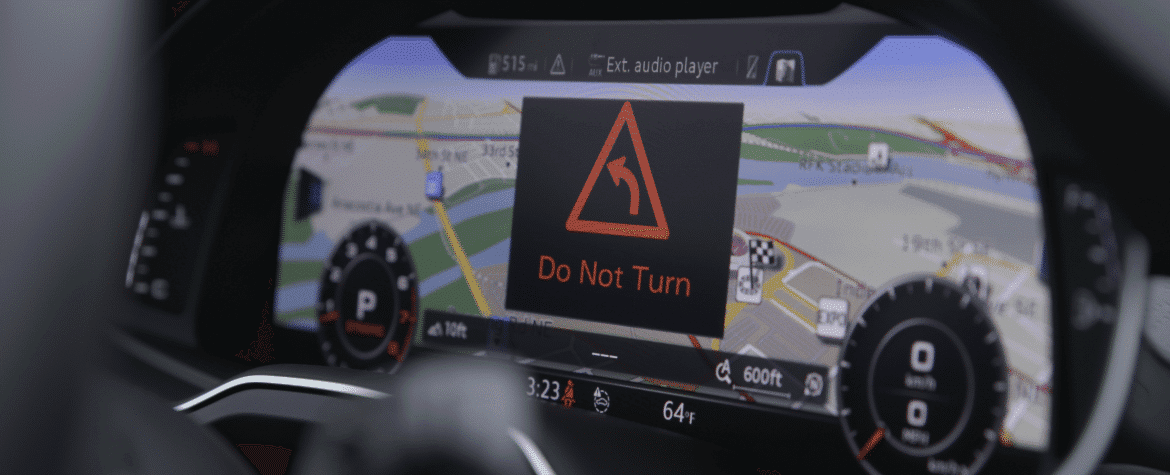
5GAA, Audi, Ford and Qualcomm Showcase C-V2X Direct Communications Interoperability to Improve Road Safety
WASHINGTON, D.C., April 26, 2018 – C-V2X Communications’ Superior Performance, Synergies with Telematics Units and Evolutionary Path Towards 5G Offers Greater Potential to Save Lives; World’s First Showcase Across Vehicle Manufacturers Shows Readiness for Industry Deployment as Early as 2020.
| Downloadable Resources | |
|---|---|
| Photos | |
| Infographic | |
| Video clip 1 | |
| Video clip 2 |
5G Automotive Association (5GAA), Audi AG (NASDAQ: AUDVF), Ford Motor Company (NYSE: F) and Qualcomm Technologies, Inc., a subsidiary of Qualcomm Incorporated (NASDAQ: QCOM), announced today the world’s first demonstration for Cellular Vehicle-to-Everything (C-V2X) direct communications technology operating across vehicles from different manufacturers. C-V2X is a global solution for V2X communications to support improved automotive safety, automated driving, and traffic efficiency, and is the only V2X technology based on globally recognized 3rdGeneration Partnership Project (3GPP) specifications with ongoing evolution designed to offer forward compatibility with 5G, and leveraging upper layer protocols defined by the automotive industry, including Society of Automotive Engineering (SAE) and the European Telecommunications Standards Institute (ETSI) organizations.
The demonstration showcased the benefits of using C-V2X real-time direct communications on the globally harmonized 5.9 GHz ITS spectrum for vehicle-to-vehicle (V2V) collision avoidance and improved road safety without any dependency on cellular operator network involvement, credentials or coverage. The organizations also unveiled initial field test results showing a significant range, reliability and performance advantage of C-V2X direct communications, with more than twice the range and improved reliability compared to 802.11p radio technology. Based on C-V2X’s potential to enhance safety and save lives, the 5GAA, Audi, Ford and Qualcomm Technologies encourage the broad automotive ecosystem to accelerate adoption of C-V2X, which is expected to be deployed as early as 2020.
Featuring Audi and Ford vehicles which incorporate the C-V2X technology utilizing the C-V2X chipset from Qualcomm Technologies, the showcase exhibited various scenarios of how C-V2X communications is beneficial for road safety. These scenarios included situations with obstructed or no visibility, including Left Turn Assist and Emergency Electronic Brake Light use cases, in which vehicle-to-vehicle (V2V) communications alerted surrounding vehicles when cars were turning left or braking. Additional use cases were featured, including a vulnerable road user (VRU) demonstration showcasing what can be possible with future vehicle-to-pedestrian (V2P) communications. Use cases for vehicle-to-infrastructure (V2I) communication were also demonstrated, which showcased how direct communications can work closely with traffic signal controllers to ensure reduction in carbon emissions and optimization of traffic efficiency in cluttered intersections and dense environments.
C-V2X is supported by a broad automotive ecosystem, that includes the fast-growing global organization 5GAA, which currently has over 80 members comprised of leading automakers, Tier-1 suppliers, software developers, mobile operators, semiconductor companies, test equipment vendors, telecom suppliers, traffic signal suppliers and road operators.
Designed with a focus on security, C-V2X benefits from established security transport layers and application protocols defined by the automotive standards communities, including SAE, ETSI, International Standards Organization (ISO), and Institute of Electrical and Electronics Engineers (IEEE) 1609, and Qualcomm’s decades of investment in cellular technologies. C-V2X solutions are expected to be more cost efficient and economical over competing technologies as this functionality gets integrated into the base cellular modem product that automakers equip in every vehicle.
“We are excited to witness this monumental breakthrough in the evolution of C-V2X and the growing momentum behind this life-saving technology,” said Christoph Voigt, Chairman of 5GAA. “After years of development supported by leading carmakers, technology providers and the automotive ecosystem at large, C-V2X is ready to improve road safety with deployment in production vehicles and road infrastructure as soon as 2020, leveraging a state-of-the-art proven radio with decade-long developed automotive software protocols. This unique showcase firstly demonstrates the commitment of our members to ensure that the potential of the C-V2X technology is realized and represents a key step towards the next generation of cellular technology, 5G.”
“C-V2X is critical to enhance road safety and also gives us a look into the key role that vehicle-to-vehicle and 5G wireless technologies play in the future of Audi and the automotive industry in general to support autonomous driving,” said Gerhard Stanzl, Head of Predevelopment Smart Mobility and Machine Learning, Audi Electronics Venture. “This interoperability demonstration marks a major milestone on the road to safer driving and we look forward to working alongside the extensive automotive ecosystem in helping accelerate C-V2X deployment globally.”
“With its ability to safely and securely connect vehicles, along with its evolution into 5G, C-V2X is integral to Ford’s vision for transportation and the cities of the future in which all cars and infrastructure collaborate speaking the same language,” said Don Butler, Executive director connected vehicle platform and product, Ford Motor Company. “We are very encouraged by preliminary test results which support our belief that C-V2X has superior V2X communication capabilities. We are also very pleased to see strong ecosystem support of product roadmaps that accelerates time to market for C-V2X.”
“At Qualcomm Technologies, we are committed to accelerating automotive innovation and enabling carmakers to deliver safe and connected vehicles, and we strongly believe that C-V2X can offer significant improvements in road safety for people worldwide,” said Nakul Duggal, vice president of product management, Qualcomm Technologies, Inc. “After years spearheading the development of C-V2X we are ready for its rollout in collaboration with leading automakers such as Audi and Ford, and the larger auto industry.”
5GAA, Audi, Ford and Qualcomm Technologies are scheduled to showcase another live C-V2X interoperability demonstration at the upcoming Intelligent Transportation Society of America (ITS-A) World Meeting in Detroit from June 4-7. Initial test results showing significant lifesaving benefits of C-V2X direct communications compared against the 802.11p solution can be found here. For more information on C-V2X please visit here.
About 5GAA
The 5G Automotive Association (5GAA) is a global cross-industry organization of companies from the automotive, technology and telecommunications industries (ICT), working together to develop end-to-end solutions for future mobility and transportation services. Created in 2016, the Association is comprised of over 80 members whose mission is to develop, test and promote communications solutions, initiate their standardization and accelerate their commercial availability and global market penetration, to address society’s connected mobility and road safety needs with applications such as automated driving, ubiquitous access to services and integration into smart city and intelligent transportation. For more information, visit 5GAA’s LinkedIn and Twitter pages.
About Audi
The Audi Group, with its brands Audi, Ducati and Lamborghini, is one of the most successful manufacturers of automobiles and motorcycles in the premium segment. It is present in more than 100 markets worldwide and produces at 16 locations in twelve countries. 100 percent subsidiaries of AUDI AG include Audi Sport GmbH (Neckarsulm), Automobili Lamborghini S.p.A. (Sant’Agata Bolognese, Italy) and Ducati Motor Holding S.p.A. (Bologna, Italy).
In 2017, the Audi Group delivered to customers about 1.878 million automobiles of the Audi brand, 3,815 sports cars of the Lamborghini brand and 55,900 motorcycles of the Ducati brand. In the 2017 fiscal year, AUDI AG achieved total revenue of €60.1 billion and an operating profit of €5.1 billion. At present, approximately 90,000 people work for the company all over the world, more than 60,000 of them in Germany. Audi focuses on sustainable products and technologies for the future of mobility.
About Ford Motor Company
Ford Motor Company is a global company based in Dearborn, Michigan. The company designs, manufactures, markets and services a full line of Ford cars, trucks, SUVs, electrified vehicles and Lincoln luxury vehicles, provides financial services through Ford Motor Credit Company and is pursuing leadership positions in electrification, autonomous vehicles and mobility solutions. Ford employs approximately 202,000 people worldwide. For more information regarding Ford, its products and Ford Motor Credit Company, please visit https://www.corporate.ford.com.
About Qualcomm
Qualcomm invents breakthrough technologies that transform how the world connects and communicates. When we connected the phone to the Internet, the mobile revolution was born. Today, our inventions are the foundation for life-changing products, experiences, and industries. As we lead the world to 5G, we envision this next big change in cellular technology spurring a new era of intelligent, connected devices and enabling new opportunities in connected cars, remote delivery of health care services, and the IoT – including smart cities, smart homes, and wearables. Qualcomm Incorporated includes our licensing business, QTL, and the vast majority of our patent portfolio. Qualcomm Technologies, Inc., a subsidiary of Qualcomm Incorporated, operates, along with its subsidiaries, all of our engineering, research and development functions, and all of our products and services businesses, including, the QCT semiconductor business. For more information, visit Qualcomm’s website, OnQ blog, Twitter and Facebook pages.
Media contact:
Lisa Boch-Andersen
Senior Director, Strategic Communication and Marketing, 5GAA
Email: lisa.boch-andersen@5GAA.org / Mobile phone: +32(0)475450972

5GAA participates in Testbed Visit in Shanghai
Shanghai, China – 16 November 2017 – following the 5G Automotive Association General Assembly Meeting, 5GAA leadership, delegates as well as representatives from Chinese and South Korean government participated in a testbed visit. This practice case was then followed by eight use-cases, demonstrating the success of the LTE-V2X advances. Both of these actions took place at the purpose-built Shanghai district – Testbed F-zone and T-Zone – where the latest developments in vehicle technology are assessed.
1. Realizing LTE-V2X’s capacity: Visit to F-Zone
Huawei LTE-V leader for Research & Development, Mr. Yangyongchao, opened the visit by showcasing LTE-V2X testing reports as well as running a live test result. This series of LTE-V2X performance tests were measured in terms of the technology’s capacity to manage two variables (link level and system level). This analysis was managed by the partnership of China Mobile (CMCC), SIAC and SAIC Motor.
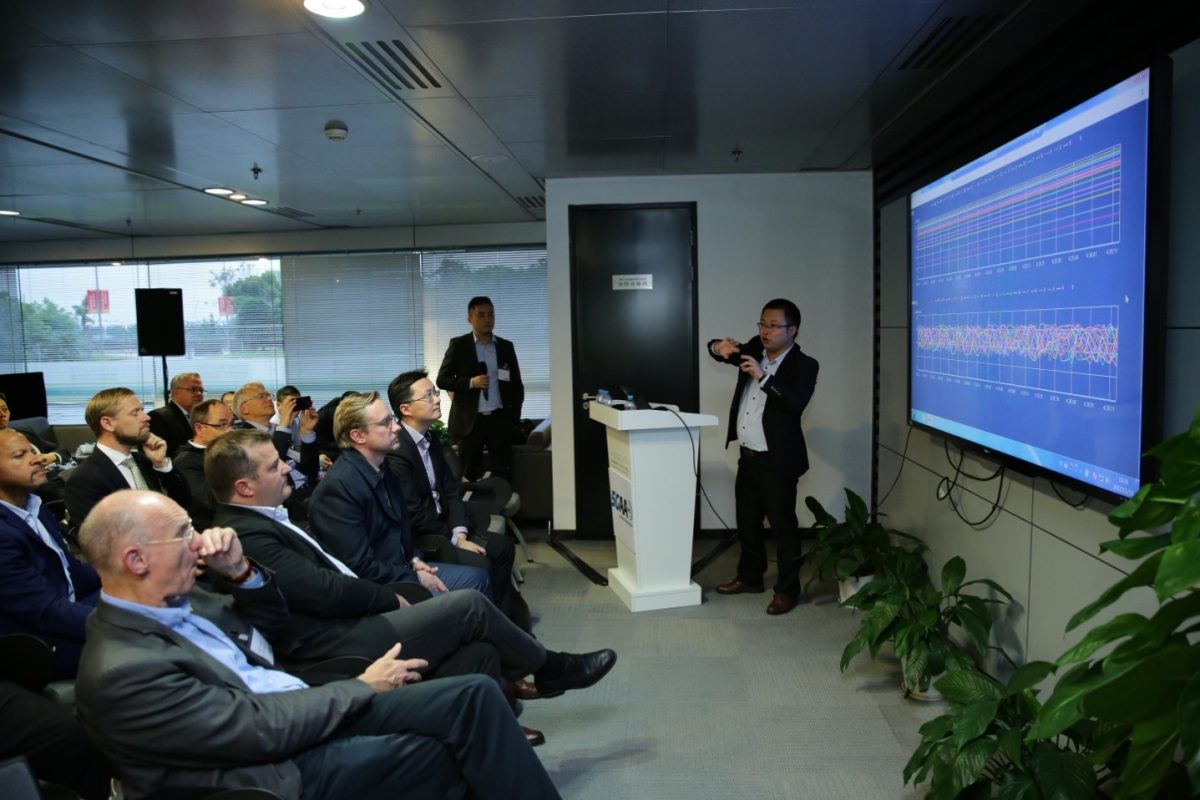
- Link Level Testing: LTE-V2X can support relative vehicle speeds of up to 500km/h, even with correction for timing and frequency errors. LTE-V2X shows excellent link performance with different packet size. The maximum RSU coverage range reaches more than 1km from the test vehicle.
- System Level Testing: 400 vehicles were analysed in this trial environment. Based on this, the capacity and of Vehicle-to-Vehicle and Vehicle- to-Infrastructure is smaller is functional in a range of 20 metres. Messages were transmitted at a success rate of 90% within the demanded communication range in high-density scenarios.
Right after this presentation, SIAC led the delegates to visit the site of F-Zone. Mr. Lilin, director of SIAC explained that F-zone is an enclosed area conducting different scenarios such as parks, urban roads with intersections, simulated highway and related road facilities. Additionally, F-zone is the national level Intelligent and Connected Vehicles test zone equipped with background vehicles, positioning capability and telecommunication infrastructure, including LTE-V2X based RSU, base stations that support both LTE and LTE-V2X, and assisted by operation system.

2. T-Zone visit
After the inspection of F-Zone, delegates visited C-V2X demonstration in T-Zone and observed eight cases in SAIC Motor’s intelligent connected vehicle operated with China Mobile and Huawei. The technology showcased was powered by 5G-V2X. This opened the vehicle up to possibilities such as Tele-Operated Driving, LTE-V2X based Platooning, Forward collision warning, Traffic light speed advisory and Vulnerable Road user warning. Dr. Liu Fen, also explained that with the abundant communications environment in T-zone and more C-V2X functionality can be realised in the future.
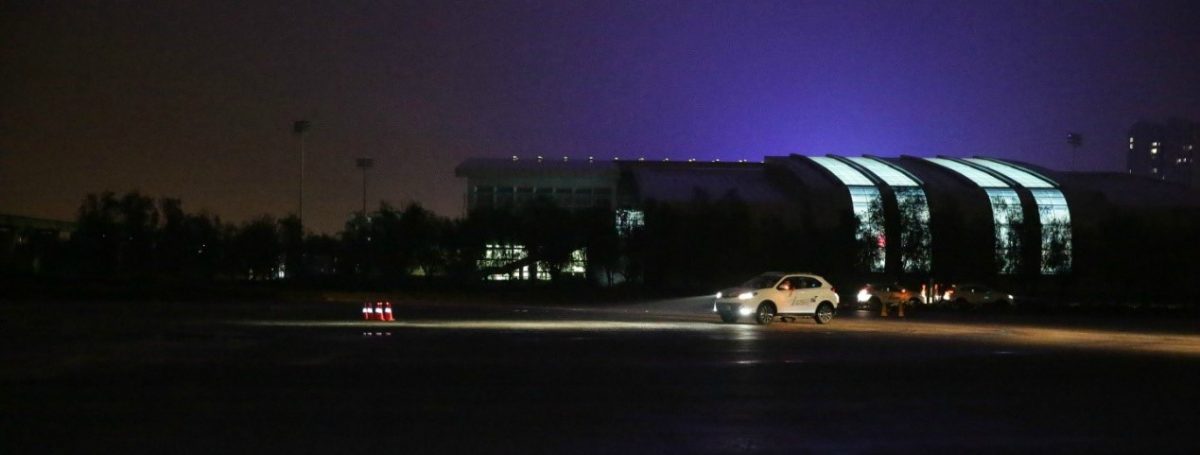
Christoph Voigt, Chairman of 5GAA, views these advances with optimism: “Today’s opportunity to see the fantastic progress from SIAC, SAIC Motor, China Mobile and Huawei is a demonstration of the unlimited possibilities that investing in 5G and LTE -V2X technologies hold. We know that C-V2X technology has the capacity for high-speed, high-density communication between vehicles, infrastructure, and pedestrians. Following further research and collaboration with our members and policy makers in governments around the world, 5GAA is looking forward to introducing this technology globally.”
Dino Flore, Director General of 5GAA is proud of the extensive partnerships that the association has fostered: “5GAA’s aim is to act as a bridge between the automotive and telecommunications industries. I would like to thank our hosts today in Shanghai for their hospitality and proudly showcasing the possibilities promised by C-V2X and 5G. Our organisation is focused on accelerating research and delivering solutions to society to build safer and more sustainable transport for our citizens. Today’s demonstrations are proof of what future holds.”
About the 5GAA
The 5G Automotive Association (5GAA) is a global cross-industry organisation of companies from the automotive, technology and telecommunications industries (ICT), working together to develop end-to-end solutions for future mobility and transportation services. Created in 2016, the Association is comprised of over 67 members which mission is to develop, test and promote communications solutions, initiate their standardization and accelerate their commercial availability and global market penetration to address societal need.
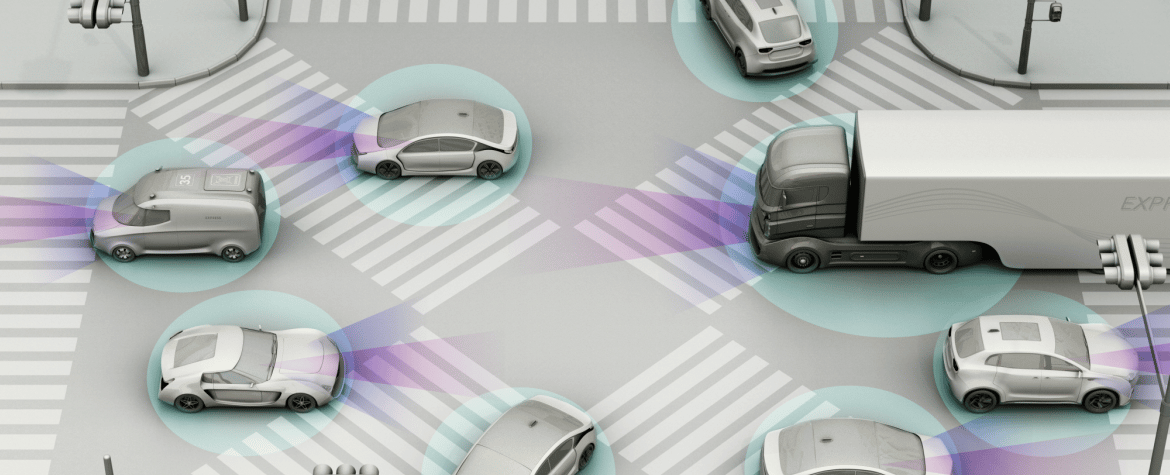
5GAA: cellular technology is key enabler for smart mobility of the future
Industry association calls on European Commission to allow stakeholders to work collaboratively towards an agreement on the technology catalyzing the mobility of the future and warns against a “premature and cumbersome legislative decision”.
The 5G Automotive Association (5GAA) encourages the automotive, technology, and telecommunications industries and the European Commission to be ambitious when evaluating technologies for connected, autonomous vehicles. 5GAA is confident that cellular communication technology (C-V2X) has the most benefits when applied to connected, self-driving cars. It has provided its views to the Commission in a workshop and a letter with recommendations. Since its launch one year ago, over 50 industry leaders from the automotive, technology and telecommunications industries have teamed up in 5GAA to accelerate C-V2X technology development and its evolution to 5G-V2X for enhanced safety, automated driving and connected mobility.
Christoph Voigt, Chairman of 5GAA said, “5GAA is confident that cellular technology (including direct vehicle-to-vehicle communication at 5.9 GHz) has the potential to lead to the best outcomes in the long run. We are strongly relying on the European institutional support to put in place a regulatory framework allowing for an industry-driven and swift deployment of this technology. It is crucial to consider how the 5.9 GHz band, the “life blood” of wireless vehicle communication, can be used efficiently in the context of 5G technology evolution, road safety, and economic scalability. The automotive and transportation sectors, both public and private, are making significant investment commitments. Therefore, we are urging the European Commission to allow the ITS-G5 and C-V2X stakeholders to work together towards an agreement on the future of connected and automated cars, without a premature and cumbersome legislative decision.”
5GAA has recently provided its views to the Commission in a workshop and a letter with recommendations.
Christoph Voigt: “We should aim high enough when selecting the solutions to make connected, self-driving vehicles a reality. These are a catalyst to improving the quality of life globally through safer traffic, improved mobility, cleaner air in cities, and a better experience overall for drivers.”
Dino Flore, Director General of 5GAA adds, “Saving lives through improved road safety is obviously the primary positive outcome of deploying communication technology solutions. In addition, we should take into account other aspects when evaluating alternatives. We’re not only talking about reducing congestion and pollution but also optimizing the driving experience. It is our view that cellular technology, including direct vehicle-to-vehicle communication at 5.9 GHz, has the most upward potential in the long run.”
Helping vehicles “understand the environment they are navigating”
Launched in September 2016 by 8 founding members the 5GAA has in less than a year grown to include over 50 leaders from the automotive, technology and telecom industries who collaborate cross-industry on the future of transport. 5GAA’s mission is to develop, test, and promote communications solutions, initiate their standardization and accelerate their commercial availability and global market penetration. The objective is to address society’s connected mobility and road safety needs with applications such as autonomous driving, ubiquitous access to services and integration into smart city and intelligent transportation.
Connected vehicles use communication technology to not only communicate with other vehicles but also with road infrastructure, other road users such as pedestrians, and the Internet – e.g. to provide traffic updates and parking guidance. Use cases include collision warnings, “traffic jam ahead” warnings, green light optimal speed advisory, parking guidance, and assisting drivers in tackling treacherous traffic situations (e.g. turning left at a crossroads). Connected vehicles will eventually reduce pollution, and make traffic more efficient, reducing congestion in cities and improving the flow of goods and people.
Christoph Voigt explains, “Equipping cars with sensors and cameras is one thing, but imagine what is possible when cars use cellular technology to communicate with their entire ecosystem: other vehicles, road users, infrastructure, and central services that give real-time information.”
“It’s the difference between a car that is capable of seeing what is happening in its immediate surroundings and one that can use all available information to allow for a safer and more comfortable driving experience. After all, as drivers we do more than purely react to what’s in front of us. We listen to traffic info, we are aware of the area we’re navigating, and we are alert to traffic jams in rush hour. We use context to guide our driving.”
“This is exactly what cellular connectivity can enable vehicles to make easier, or even take over from us in the case of self-driving vehicles. Except that it will be faster and more accurate,” concludes Christoph Voigt.
-Ends
About 5GAA
The 5G Automotive Association (5GAA) is a global cross-industry organisation of companies from the automotive, technology and telecommunications industries (ICT), working together to develop end-to-end solutions for future mobility and transportation services. Created in 2016, the Association is comprised of over 50 members which mission
is to develop, test and promote communications solutions, initiate their standardization and accelerate their commercial availability and global market penetration to address societal need. For more information please visit 5gaa.org
Contacts
Robbe Libbrecht
FINN PR
robbe.libbrecht@finnpr.com
M +32 497 23 30 38
5GAA Marketing & Communications
marcom@5GAA.org


